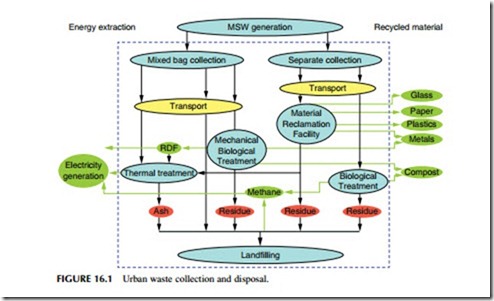The generation of power from waste is a very specialized industry. Power-from- waste plants are designed to burn residual urban waste that cannot be recycled to reduce its volume, destroy potentially hazardous materials, and generate heat and power. The plants include extensive environmental controls to ensure that they do not release any toxic emissions and are consequently expensive to build. However, their economics do not depend on the value of the electricity they produce since the operators are paid for the volume of waste they process. In this sense electricity and heat are valuable by-products.
Urban waste is a major problem throughout both the developed and the developing world but it is in the advanced economies of North America, Europe, and some nations in southeast Asia that the problem is greatest. These economies generate large volumes of glass, metal, paper, plastic, and organic waste that must be collected, sorted, and then treated or stored in some way. At the top of the national league is Canada, which produces around 780 kg for each person every year. The average amount of waste generated per person per year in the European Union (EU) is 577 kg, and some individual EU nations such as Ireland are at the upper end of national rates of waste production. At the other end of the scale of advanced coun- tries is Japan with a per-capita output of less than 400 kg. In contrast, a typical town dweller in Sub-Saharan Africa may produce less than 100 kg each year.
Once urban or municipal waste has been collected, there are three primary ways in which it can be handled, as shown in Figure 16.1. The first, and perhaps the most important today, is to sort it and then recycle everything that can be reused. This should include the composting of organic waste so that it can be returned to the soil. The second option is to burn the waste. Not all will be com- bustible but a large part of urban waste can be burned including parts that should ideally be recycled. The final option is to bury it in a landfill site. This is the easy option and was preferred in the past in many countries, but pressure on land coupled with greater environmental awareness is leading to a reduction in the use of landfills in most advanced economies.
The level of exploitation of waste-to-energy plants varies from country to country. They have been used widely in parts of Europe, where waste has been burned since the end of the 19th century, and form a major part of Japan’s waste disposal strategy. In contrast, the United Kingdom and United States have only adopted the technology patchily, while some nations, such as Ireland and Greece,
do not incinerate any waste. This is partly tradition, but environmental concerns about the emissions from the plants have resulted in local resistance to their construction in some parts of the world. More advanced emission treatment processes may make it easier to build these plants in the future.
Some countries have used the incineration of waste extensively. In Sweden, for example, 14% of municipal waste is put into landfill sites, 41% recycled, and 45% is incinerated. By contrast, the United Kingdom disposes of 74% of its waste in landfill sites, recycles 18%, and incinerates 8%. The Netherlands, meanwhile, incinerates 33%, recycles 64%, and only disposes of 3% in landfill sites. Within the EU, Denmark has the highest incineration rate of 54%.
Where they are employed, power-from-waste plants generally burn domestic and urban refuse—called in this context municipal solid waste (MSW)— using the resulting heat to generate steam to drive a conventional steam turbine. MSW can also be sorted and treated to produce a compacted fuel called refuse- derived fuel (RDF) that can be burned in a power station. Some industrial waste may be treated in the same way. However, industrial wastes are likely to contain toxic materials that have to be handled using special procedures. Where such care is not required, they can be dealt with in the same way as urban waste.
In addition to municipal waste and industrial waste there are a number of other categories of waste, primarily resulting from the agricultural and forestry industries, that can be used to generate electricity. These have been dealt with under biomass in Chapter 15. That chapter also dealt with the collection and use of methane produced in landfill refuse disposal sites. However, we need to con- sider landfill briefly here since it offers the main alternative to waste combustion for all urban waste that cannot be recycled.
